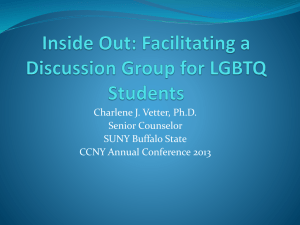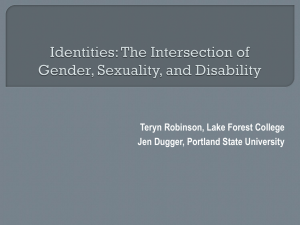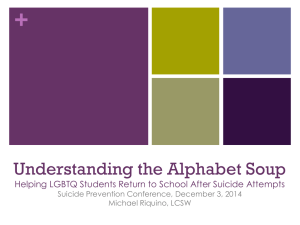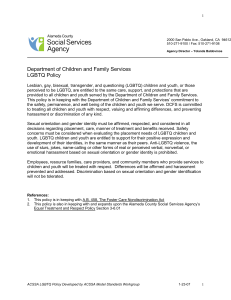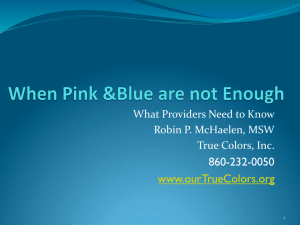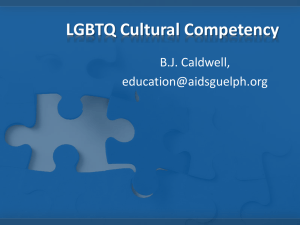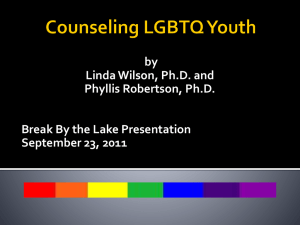112 - American Bar Association
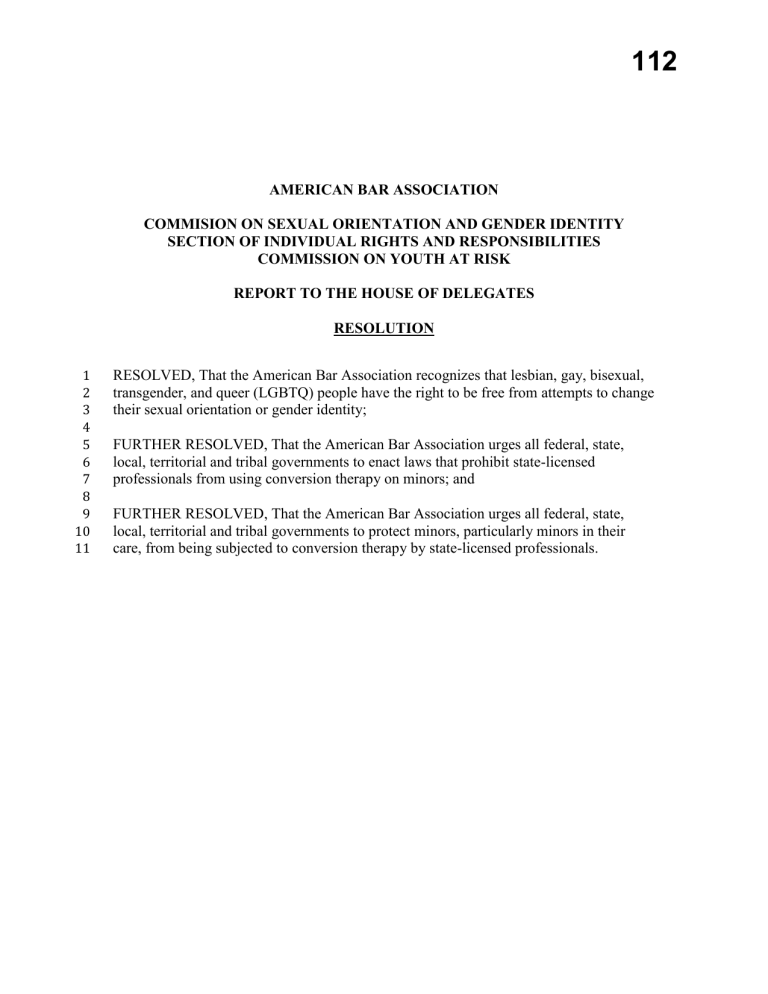
112
AMERICAN BAR ASSOCIATION
COMMISION ON SEXUAL ORIENTATION AND GENDER IDENTITY
SECTION OF INDIVIDUAL RIGHTS AND RESPONSIBILITIES
COMMISSION ON YOUTH AT RISK
REPORT TO THE HOUSE OF DELEGATES
RESOLUTION
5
6
7
1
2
3
4
8
9
10
11
RESOLVED, That the American Bar Association recognizes that lesbian, gay, bisexual, transgender, and queer (LGBTQ) people have the right to be free from attempts to change their sexual orientation or gender identity;
FURTHER RESOLVED, That the American Bar Association urges all federal, state, local, territorial and tribal governments to enact laws that prohibit state-licensed professionals from using conversion therapy on minors; and
FURTHER RESOLVED, That the American Bar Association urges all federal, state, local, territorial and tribal governments to protect minors, particularly minors in their care, from being subjected to conversion therapy by state-licensed professionals.
112
REPORT
The American Bar Association (“ABA”) has a long history of advocating for the rights of those discriminated against on the basis of race, gender, national origin, disability, age, sexual orientation, and gender identity/expression. The ABA has been a leader in opposing and eradicating bigotry and prejudice against LGBTQ
1
people. It has adopted policies urging the repeal of laws that criminalize private, consensual sexual conduct between consenting adults
(1973); condemning hate crimes, including those based on sexual orientation, and urging prosecution of the perpetrators (1987); and calling on the governments of countries with discriminatory laws, regulations, and practices to repeal them and ensure the safety and equal protection under law of all LGBTQ people (2014).
I.
Conversion Therapy Causes Serious Harms to LGBTQ People and Especially to
LGBTQ Children and Youth
A.
The Practices of Conversion Therapy
The practices used in conversion therapy are sometimes referred to as reparative therapy, ex-gay therapy, or sexual orientation change efforts (“SOCE”). In the past, some mental health professionals resorted to extreme measures such as forced institutionalization, forced medication, castration, and electroconvulsive shock therapy to try to stop people from being LGBTQ.
2
According to a 2009 report of the American Psychological Association (the “APA”), the techniques therapists have used to try to change sexual orientation and gender identity include inducing nausea, vomiting, or paralysis while showing the patient homoerotic images; providing electric shocks; having the individual snap an elastic band around the wrist when aroused by same-sex erotic images or thoughts; using shame to create aversion to same-sex attractions; orgasmic reconditioning; and satiation therapy.
3
Other techniques have included trying to make patients’ behavior more stereotypically feminine or masculine, teaching heterosexual dating skills, and using hypnosis to try to redirect desires and arousal—all based on the scientifically discredited premise that being LGBTQ is a psychological defect or a disorder that calls for eradication.
4
The current practice guidelines for the National Association for Research & Therapy of Homosexuality (NARTH), which is a group of therapists who endorse and practice conversion therapy in the United States, encourage its
1 The term “LGBTQ” refers to lesbian, gay, bisexual, transgender, and queer individuals. “Queer” is an umbrella term sometimes used by LGBTQ people to refer to the entire LGBT community; genderqueer.”
2 See, e.g., David B. Cruz , Controlling Desires: Sexual Orientation Conversion and the Limits of Knowledge and
Law, 72 S. Cal. L. Rev. 1297, 1304-05 (1999); Robert J. Cramer , et al, Weighing the Evidence: Empirical
Assessment and Ethical Implications of Conversion Therapy, 18 Ethics & Behavior 93-114 (2008).
3 Judith Glassgold et al., Am. Psychological Ass’n, Report of the American Psychological Association Task Force on Appropriate Therapeutic Responses to Sexual Orientation 22 (2009), available at https://www.apa.org/pi/LGBT/resources/therapeutic-response.pdf.
4 See id .; see generally Timothy F. Murphy, Redirecting Sexual Orientation: Techniques and Justifications , 29 J.
Sex Research 501 (1992).
1
112 members to consider techniques that include hypnosis, behavior and cognitive therapies, sex therapies, and psychotropic medication, among others.
5
Today, while some counselors still use aversive conditioning, the techniques most commonly used include a variety of behavioral, cognitive, psychoanalytic, and other practices that try to change or reduce same-sex attraction or alter a person’s gender identity. These methods are as equally devoid of scientific validity as the techniques relied upon in the past and pose similarly serious dangers to patients—especially to minors, who are often forced or coerced into undergoing them by their parents or legal guardians, and who are at especially high risk of being harmed. The use of conversion therapy on children and adolescents poses particular ethical problems because minors cannot effectively refuse or resist treatment wanted by their parents or other authorities.
B.
Medical and Child Welfare Experts Have Condemned Conversion
Therapy as Ineffective, Unsafe, and Completely Out-of-Step with the
Current Scientific Understanding of Sexual Orientation and Gender
Identity
The nation’s leading medical and mental health organizations have concluded that attempts to change a person’s sexual orientation or gender identity lack any scientific basis and present significant risks of physical and mental harm to patients who undergo them. For example, the
APA has warned that sexual orientation change efforts can pose critical health risks, including
“confusion, depression, guilt, helplessness, hopelessness, shame, social withdrawal, [and] suicidality,” among other negative consequences.
6
In particular, the APA determined that “[t]he potential risks of reparative therapy are great, including depression, anxiety and self-destructive behavior.” 7
And the American Academy of Child and Adolescent Psychiatry found that “there is no evidence that sexual orientation can be altered through therapy,” and that “there is no medically valid basis for attempting to prevent homosexuality, which is not an illness.” 8
Other professional organizations with similar policy statements include the American Academy of Pediatrics, American Association for Marriage and Family Therapy, American Counseling
Association, American Medical Association, American Psychiatric Association, American
Psychoanalytic Association, American School Counselor Association, American School Health
Association, National Association of Social Workers, and the Pan American Health Organization
(a regional office of the World Health Organization). These organizations have stated that sexual orientation change efforts (1) are unnecessary and offer no therapeutic benefit because they
5 See NARTH Institute, http://www.narth.com/main-issues/born-that-way-theory/ (last visited Apr. 4, 2015).
6 Glassgold et al., supra
7 Am. Psychiatric Ass’n, Position Statement on Therapies Focused on Attempts to Change Sexual Orientation
(Reparative or Conversion Therapies) (2000), available at www.Psychiatry.org/File%20Library/Advocacy%20and%20Newsroom/Position%20Statements/ps2000_Reparative
Therapy.pdf.
8 Am. Acad. of Child & Adolescent Psychiatry, Practice Parameter on Gay, Lesbian, or Bisexual Sexual
Orientation, Gender Nonconformity, and Gender Discordance in Children and Adolescents , 51 J. Am. Acad. Child
& Adolescent Psychiatry 957 (2012), available at www.Guideline.gov/Content.aspx?id=38417#Section420.
2
112 attempt to “cure” something that is not an illness and requires no treatment, (2) are contrary to the modern scientific understanding of sexual orientation, (3) are ineffective, and (4) carry a risk of serious harm to patients.
9
Many survivors report that the conversion therapy was ineffective and succeed only in causing them great pain and anxiety. For example, one man who underwent sexual orientation change efforts beginning when he was six years old because his parents were concerned that he was “too feminine” explains that he “was made to feel by doctors that there was something wrong with him” and “was made to feel shame and engage in a fruitless labor that left him sad and broken.” 10
Another survivor reports that his experiences with conversion therapy as a teenager drove him “to the brink of suicide” and led to “depression, periods of homelessness, and drug abuse.” 11
Sadly, other young people who have undergone conversion therapy have not survived. The recent tragic death by suicide of Leelah Alcorn, a transgender teenage girl who was forced to undergo conversion therapy by her parents, further underscores the urgent need to protect
LGBTQ youth from these dangerous and discredited practices.
12
Statutory prohibitions on conversion therapy protect young people like her from being subjected to these harmful practices and protect families from the terrible pain of discovering that they have been defrauded and
9 Am. Acad. of Pediatrics, Homosexuality and Adolescence , 92 Pediatrics 631 (1993), available at http://pediatrics.aappublications.org/content/92/4/631.full.pdf+html; Am. Ass’n for Marriage and Family Therapy,
2015 Policy on Social and Family Policies (2015), available at www.AAMFT.org/imis15/content/about_aamft/position_on_couples.aspx; Am. Counseling Ass’n, Ethical Issues
Related to Conversion or Reparative Therapy (2013), available at www.Counseling.org/news/updates/2013/01/16/Ethical-Issues-Related-to-Conversion-or-Reparative-Therapy; Am.
Med. Ass’n, Health Care Needs of Gay Men and Lesbians in the United States , 275 J. Am. Med. Ass’n 1354 (1996), available at http://www.hawaii.edu/ hivandaids/Health_Care_Needs_of_Gay_Men_and_Lesbians_in_the_United_States.pdf; Am. Psychiatric Ass’n, supra
Position Statement on Attempts to Change Sexual Orientation, Gender
Identity, or Gender Expression (2012), available at http://www.apsa.org/content/2012-position-statement-attemptschange-sexual-orientation-gender-identity-or-gender; Am. Sch. Counselor Ass’n, The Professional School
Counselor and LGBTQ Youth (2014), available at http://www.schoolcounselor.org/asca/media/asca/PositionStatements/PS_LGBTQ.pdf; Am. Sch. Health Ass’n,
Quality Comprehensive Sexuality Education (2007); Nat’l Ass’n of Soc. Workers, “Reparative” or “Conversion”
Therapies for Lesbians and Gay Men (2000), available at www.NASWDC.org/diversity/lgb/reparative.asp; Pan
Am. Health Org.: Regional Office of the World Health Organization, “Cures” for an Illness That Does Not Exist:
Purported Therapies Aimed at Changing Sexual Orientation Lack Medical Justification and Are Ethically
Unacceptable (2012), available at www.paho.org/hq/index.php?option=com_docman&task=doc_view&gid=17703.
10 See #BornPerfect: Survivor Stories & Survivor Network, National Center for Lesbian Rights, http://www.nclrights.org/bornperfect-survivor-stories-and-survivor-network/ (last visited Apr. 8, 2015) (on file with organization).
11 Id.
12 Sharon Coolidge,
Transgender Teen: ‘My Death Needs to Mean Something,’
Cincinnati.com, (Dec. 31, 2014, 2:03
PM), http://www.cincinnati.com/story/news/2014/12/30/transgender-teen-death-needs-mean-something/21044407/; see also Shannan Wilber, NCLR Statement on the Loss of Leelah Alcorn (Jan. 2, 2015), http://www.nclrights.org/press-room/press-release/nclr-statement-on-the-loss-of-leelah-alcorn/.
3
112 misled by licensed therapists who abuse their state licenses to harm vulnerable families and children.
13
C.
Conversion Therapy Is Particularly Dangerous for Minors
Conversion therapy constitutes a particularly grave health risk for LGBTQ youth.
14
As documented by Dr. Caitlin Ryan’s research through the Family Acceptance Project, conversion therapy often occurs within the context of other rejecting behaviors and attitudes within the family.
15
As Ryan explains, “[p]arents who reject their LGBT children are typically motivated by trying to help, not hurt them,”
16
which makes parents vulnerable to false and misleading claims by therapists that treatment can change a child’s sexual orientation or gender identity. Ryan’s research found that “[m]any families respond to their LGBT and gender-diverse children by isolating them, preventing access to support, sending them to clergy and providers to try to change their LGBT identity and using religion to condemn or deny their LGBT identity.” 17
Parents are “often surprised and even shocked to learn that their gay children experience these reactions as rejection and abuse.” 18
This is an enormous source of familial conflict, and puts children at risk of psychological stress, loss of hope, depression, and poor self-esteem.
19
Family conflict over a youth’s sexual orientation and gender identity places youth at high risk of serious, long-term negative impacts on their health and well-being. As documented by Ryan and others, there is a strong correlation between family acceptance and lasting positive impacts on a young person’s health and well-being. Conversely, LGBTQ youth who are rejected by their families because of their sexual orientation or gender expression/identity are at a dramatically increased risk of significant negative health outcomes, including serious depression, substance abuse, HIV infection, and suicide attempts.
20
13 See Wilber, supra
14 See generally Caitlin Ryan & Robert A. Rees, Family Acceptance Project, Supportive Families, Healthy Children:
Helping Latter-day Saint Families with Lesbian, Gay, Bisexual & Transgender Children (2012), available at http://www.theldsfamilyfellowship.org/wp-content/uploads/2013/09/FAP-LDS-Booklet-pst.pdf. As many as one in three LGBTQ youth have been subjected to conversion therapy. Decl. of Caitlin Ryan in Support of Equality
California’s Amicus Brief at 5, Welch v. Brown , 907 F. Supp. 2d 1102 (E.D. Cal. 2012), rev'd sub nom.
Pickup v.
Brown , 728 F.3d 1042 (9th Cir. 2013) and rev'd sub nom.
Pickup v. Brown , 740 F.3d 1208 (9th Cir. 2014) (No.
2:12-CV-02484-WBS-KJN); see also Coalition LGBT Advocate Letter against Conversion Therapy , National
Center for Lesbian Rights (2014), http://www.nclrights.org/wp-content/uploads/2014/06/Conversion-Therapy-
LGBT-Advocate-Letter.pdf (“Youth forced to undergo ‘therapy’ that attempts to fix an identity that is purportedly broken does nothing but increase the already disproportionate risks LGBT youth face.”).
15 See Ryan & Rees, supra
16 Caitlin Ryan, Parents Don’t Have to Choose between Their Faith and Their LGBT Kids , Wash. Post, Jan. 7, 2015, http://www.washingtonpost.com/national/religion/parents-dont-have-to-choose-between-their-faith-and-their-
LGBT-kids-commentary/2015/01/07/e3ec4a9c-96bc-11e4-8385-866293322c2f_story.html.
17 Id.
18 Rees & Ryan, supra
19 Id. at 9.
20 Caitlin Ryan et al., Family Rejection as a Predictor of Negative Health Outcomes in White and Latino Lesbian,
Gay, and Bisexual Young Adults , J. of Am. Acad. of Pediatrics 346, 350-51 (2009).
4
112
According to Ryan’s research, gay, lesbian, and bisexual young adults who experienced high levels of family rejection in adolescence based on their sexual orientation—of which conversion therapy is one form—are 8.4 times more likely to report having attempted suicide and 5.9 times more likely to report high levels of depression than peers from families reporting no or low levels of rejection.
21
Transgender youth are at even higher risk of depression and suicide attempts—45% of transgender people between the ages of 18 and 24 report at least one suicide attempt—and exposure to conversion therapy only heightens suicidality.
22
Moreover, while family acceptance of LGBTQ youth is increasing, the younger age at which youth are identifying at LGBTQ has created a heightened window of vulnerability, exposing more children to the risk of family rejection at earlier ages. In its 2006 study, the National Gay and Lesbian Task Force reported that 50% of gay teens experienced a negative reaction from their parents when they came out.
23
Notably, in its 2009 investigation of conversion therapies, the APA noted that it undertook that study in part based upon “concerns about the resurgence of individuals and organizations that actively promoted the idea of homosexuality as a developmental defect or a spiritual and moral failing and that advocated psychotherapy and religious ministry to alter homosexual feelings and behaviors.” 24
Family rejection is also a significant factor leading to homelessness and entrance into the child welfare and juvenile justice systems, where LGBTQ youth are at risk of being subjected to efforts to change their sexual orientation or gender identity.
25
According to one study, 26% of
LGBTQ teens were kicked out of their homes when they disclosed their sexual orientation to their parents.
26
This contributes to an epidemic of homelessness among this population.
According to the United States Interagency Council on Homelessness, an estimated 20-40% of homeless youth are LGBTQ, more than double the number of LGBTQ people in the general
21 Id.
22 Jaime M. Grant et al., National Transgender Discrimination Survey (2011).
23 Nicholas Ray, Lesbian, Nat’l Gay & Lesbian Task Force Policy Institute & Nat’l Coal. for the Homeless, Gay,
Bisexual, and Transgender Youth: An Epidemic of Homelessness 2 (2006). The most recent social science research indicates that gay and lesbian youth are becoming aware of their same-gender attractions at approximately age nine for boys, and at age ten for girls. See Wesley Ware, Juvenile Justice Project of La., Locked Up & Out: Lesbian, Gay,
Bisexual, & Transgender Youth in Louisiana’s Juvenile Justice System 14 (2010), available at http://jjpl.org/site/wpcontent/uploads/2011/07/locked-up-and-out.pdf.
24 Judith Glassgold et al., Am. Psychological Ass’n, Report of the American Psychological Association Task Force on Appropriate Therapeutic Responses to Sexual Orientation 12 (2009), available at https://www.apa.org/pi/LGBT/resources/therapeutic-response.pdf.
25 Ray, supra
see also Nat’l Ctr. for Lesbian Rights, LGBTQ Youth in the Foster Care System 1 (2006), available at http://nwnetwork.org/wp-content/uploads/2012/08/2006-NCLR-LGBTQ-Youth-in-the-Foster-Care-
System.pdf.
26 Nat’l Ctr. for Lesbian Rights, LGBTQ Youth in the Foster Care System, supra
see also Nat’l Ctr. for
Lesbian Rights, LGBTQ Youth in the Juvenile Justice System 1-2 (2006), available at http://www.nclrights.org/legal-help-resources/resource/lgbtq-youth-in-the-juvenile-justice-system-fact-sheet/.
LGBTQ youth routinely experience harassment and abuse within the child welfare system from staff, foster parents, and other foster youth peers. See also Barbara Fedders, Coming Out for Kids: Recognizing, Respecting, and
Representing LGBTQ Youth, 6 Nev. L.J. 101, 121 (2006), available at http://www.equityproject.org/pdfs/Fedders%20-%20Coming%20Out%20for%20Kids.pdf.
5
112 population.
27
Similarly, LGBTQ youth are also dramatically overrepresented in the juvenile justice system and those who enter the juvenile justice system are “twice as likely to have experienced family conflict, child abuse, and homelessness as other youth.”
28
In addition to being at heightened risk of ending up in the child welfare and juvenile justice systems, LGBTQ youth are at heightened risk of being subjected to attempts—both by therapists and others—within those systems. Community organizations and state agencies designed to assist youth who have been rejected by their families are often not trained to provide culturally competent care and assistance to LGBTQ youth. As the Center for American Progress documented in its 2012 report, programs such as “foster care [placements], health centers, and other youth-serving institutions[ ] are often ill-prepared or unsafe for gay and transgender youth due to institutional prejudice, lack of provider and foster-parent training, and discrimination against gay and transgender youth by adults and peers.” 29 While no hard data exists, many juvenile justice advocates and youth who have been in the juvenile justice system report that
LGBTQ youth are often pressured to change their sexual orientation or gender identity, including by judges, therapists, and other staff.
30
II.
Legal Protections from Conversion Therapy
Despite being overwhelmingly rejected by the medical community, currently only three jurisdictions in the United States protect families from mental health professionals—licensed and authorized to practice by the state—engaging in efforts to change a young person’s sexual orientation or gender identity.
31
In 2012, California became the first state to prohibit state-licensed mental health professionals from practicing conversion therapy on minors.
32 New Jersey followed in 2013.
33 Most recently in
2014, the District of Columbia became the third jurisdiction to pass such a law. The D.C.
Council approved the bill unanimously on December 2, 2014, and Mayor Vincent Gray signed the bill into law on December 22, 2014.
34 These laws prohibit state-licensed therapists from
27 LGBTQ Youth Homelessness in Focus , United States Interagency Council on Homelessness, http://usich.gov/issue/lgbt_youth/lgbtq_youth_homelessness_in_focus/ (last visited April 6, 2015).
28 Jerome Hunt & Aisha Moodie-Mills, Center for American Progress, The Unfair Criminalization of Gay and
Transgender Youth: An Overview of the Experiences of LGBT Youth in the Juvenile Justice System 2 (June 29,
2012), available at http://www.americanprogress.org/wp-content/uploads/issues/2012/06/pdf/juvenile_justice.pdf.
29 Id.
30 See Katayoon Majd et al., Legal Servs. for Children, Nat’l Juvenile Defender Ctr. & Nat’l Ctr. for Lesbian Rights,
Hidden Injustice: Lesbian, Gay, Bisexual, and Transgender Youth in Juvenile Courts (2009), available at http://www.equityproject.org/pdfs/hidden_injustice.pdf.
31 See Cal. Bus. & Prof. Code §§ 865-865.2 (West); D.C. Code § 7-1231.14a; N.J. Stat. Ann. §§ 45:1-54-55 (West).
According to the Movement Advancement Project, 83% of the LGBTQ population resides in states with no laws protecting minors from conversion therapy. See Conversion Therapy Laws, Movement Advancement Project, http://www.LGBTmap.org/equality-maps/conversion_therapy (last visited Apr. 4, 2015).
32 See Cal. Bus. & Prof. Code §§ 865-865.2 (West).
33 S ee N.J. Stat. Ann. §§ 45:1-54-55 (West).
34 D.C. Code §§ 7-1231.02(25A), 7-1231.14a; see also Conversion Therapy for Minors Prohibition Amendment Act of 2013, D.C. Act 20-530 (2014).
6
112 engaging in scientifically discredited and dangerous practices that try to change a young person’s sexual orientation or gender identity.
The prohibitions in California, the District of Columbia, and New Jersey describe the practice of conversion therapy as “sexual orientation change efforts” (SOCE), which is the scientific term used by the American Psychological Association and other groups that have warned patients about these dangerous practices. These laws provide that state-licensed mental health providers may not engage in sexual orientation change efforts with a patient under the age of eighteen.
The legal definition of SOCE encompassed by these bills includes any practices by mental health providers that seek to change an individual’s sexual orientation or gender identity. This includes efforts to change behaviors or gender expression, or to eliminate or reduce sexual or romantic attractions or feelings toward individuals of the same sex. The laws also state that SOCE do not include therapies that provide acceptance, support, and understanding of clients or the facilitation of clients’ coping, social support, and identity exploration and development, including sexual orientation-neutral efforts to prevent or address unlawful conduct or unsafe sexual practices.
They specifically exempt therapy designed to aid a person in a transition from one gender to another.
III.
Litigation Involving Conversion Therapy
A.
Litigation Defending Laws Protecting Minors from Conversion Therapy
Two federal courts of appeals have upheld state laws prohibiting licensed mental health professionals from subjecting minor patients to conversion therapy against challenges arguing that such laws violate the First Amendment or the right of parents to control their children’s upbringing. These courts have concluded that these statutes are a valid exercise of the state’s power to regulate the medical profession and to protect public health and safety. Comparable to other laws that protect the public against ineffective and unsafe treatment by licensed professionals, these laws ensure that state-licensed mental health providers cannot subject minor patients to dangerous, ineffective, and discredited practices. Further, they ensure that those providers cannot defraud and mislead vulnerable parents—who count on the law to regulate medical professionals—into unknowingly placing their children at risk of such serious harms.
These state statutes are grounded in existing state licensing protocols and administrative mechanisms that regulate licensed mental health professionals. i.
Pickup v. Brown: Upholding California SB 1172
State and federal courts have upheld prohibitions against conversion therapy and allowed state regulation of its practitioners. In Pickup v. Brown , the Ninth Circuit upheld a California law prohibiting licensed mental health practitioners from providing conversion therapy to children under the age of eighteen.
35
The law was supported by a large and diverse group of prominent mental health professional organizations and social services providers, including the California
Psychological Association, the California Division of the American Association for Marriage
35 740 F.3d 1208 (9th Cir.), cert. denied , 134 S. Ct. 2871 (2014) and cert. denied sub nom.
Welch v. Brown , 134 S.
Ct. 2881 (2014).
7
112 and Family Therapy, the National Association of Social Workers, and others.
36
Nevertheless, a small group of therapists and parents wishing to provide conversion therapy to their minor patients and children challenged the law.
In response to constitutional claims raised by the challengers, the Ninth Circuit found that
“[p]ursuant to its police power, California has authority to regulate licensed mental health providers’ administration of therapies that the legislature has deemed harmful.” 37
Because the
California prohibition regulated treatment, not protected speech, and the legislature had determined, based upon the overwhelming consensus of medical authority, that conversion therapy is ineffective and unsafe, the state had the authority to prevent licensed therapists from using the practice on minor children.
38 ii.
King v. Christie: Upholding New Jersey AB 3371
The Third Circuit came to similar conclusions in King v. Christie , upholding a New Jersey law that prohibited state-licensed therapists from trying to change the sexual orientation or gender identity of minor patients.
39
The court upheld New Jersey’s prohibition on conversion therapy as a permissible restriction on professional speech. The court found that mental health providers’ communications with their patients in the course of providing treatment constituted professional speech, and that restrictions on that speech trigger intermediate scrutiny under the First
Amendment.
40
The court ruled that New Jersey’s prohibition on this type of professional speech easily passed review under intermediate scrutiny because
It is not too far a leap in logic to conclude that a minor client might suffer psychological harm if repeatedly told by an authority figure that her sexual orientation—a fundamental aspect of her identity—is an undesirable condition.
Further, if [conversion therapy] counseling is ineffective—which, as we have explained, is supported by substantial evidence—it would not be unreasonable for a legislative body to conclude that a minor would blame herself if her counselor’s efforts failed.
41
Given the “substantial evidence” of harm presented to state legislators, the court found that their concern about conversion therapy—and thus, the regulation—was valid.
42
36 See, e.g.
, Brief of Amici Curiae American Association for Marriage and Family Therapy – California Division et al. Supporting Defendants-Appellees Urging Affirmance, Pickup v. Brown , 740 F.3d 1208, 1227 (9th Cir.), cert. denied , 134 S. Ct. 2871 (2014), and cert. denied sub nom.
Welch v. Brown , 134 S. Ct. 2881 (2014) (No. 12-17681).
37 Pickup, 740 F.3d at 1229.
38 Id.
39 King v. Christie , 767 F.3d 216 (3d Cir. 2014).
40 Id. at 233
41 Id. at 239.
42 Id.
8
112
B.
Affirmative Litigation
In early 2015, a New Jersey Superior Court concluded that “any expert opinion based on the initial premise that homosexuality is a mental disorder or abnormal is unreliable and . . . barred.” 43
The lawsuit charged that a pro-conversion therapy organization, Jews Offering New
Alternatives for Healing (“JONAH”), its founder, and a counselor violated New Jersey’s
Consumer Fraud Act by claiming that their counseling services could cure clients of being gay.
The court excluded experts from testifying that homosexuality is a disorder, finding that “the generally accepted scientific theory is that homosexuality is not a mental disorder and not abnormal” given the removal of homosexuality from the Diagnostic and Statistical Manual of
Mental Disorders (“DSM”) and the “countless organizations [that] have followed the [American
Psychiatric Association’s] lead in removing homosexuality from its listings of mental disorders.” 44
The court went on to rule that professional claims that being LGBTQ is a curable mental disorder constitute consumer fraud.
45
C.
Criminal Cases
Criminal charges have been brought in some cases where the mistreatment conversion therapy survivors have experienced rises to the level of criminal conduct. i.
Jeff White
Criminal charges are pending in cases of alleged sexual abuse by practitioners of conversion therapy, such as a case involving allegations by Jeff White against his former school, the Bethel
Baptist School in Walls, Mississippi. White’s parents sent their son to Bethel Baptist because the school claimed that they could cure their son of his homosexuality.
46
White, now an adult, says that one of his teachers would regularly schedule “appointments” with White each Wednesday in his classroom or an office and would force him to have oral or anal sex because of his sexual orientation.
47
“He would rape me because I was gay and because it would make me hate men and make me change,” White said.
48
White endured this abuse from 1996 to 1999.
49
White is now the executive director of the Mississippi Gulf Coast Rainbow Center, the first LGBTQ center in the state.
43 Ferguson v. JONAH , No. L-5473-12, slip op. at 27 (N.J. Super. Ct. Feb. 5, 2015).
44 Id. at 23, 26.
45 See Ferguson v. JONAH , No. L-5473-12 (N.J. Super. Ct. Feb. 10, 2015) (order granting plaintiffs’ motion for partial summary judgment).
46 Cavan Sieczkowski, Man Claims Church Teacher Raped Him as a Gay Cure , The Huffington Post (Sept. 3, 2014,
6:59 PM), http://www.huffingtonpost.com/2014/09/03/church-teacher-rape-gay-cure_n_5760782.html.
47 Id.
48 Id.
49 Id.
9
112 ii.
Matthew Fenner
In December 2014, a grand jury indicted five members of a church in Spindale, North Carolina for felony charges related to the attack and beating of a fellow church member, Matthew Fenner, who identifies as gay.
50
The charges result from at least three instances where church members attacked Fenner in attempts to change his sexual orientation.
51 In a January 2013 incident, Fenner was threatened with confinement for two days, slapped, strangled and verbally assaulted to
“free” him from “homosexual demons.” 52
Fenner said that as many as fifteen to twenty collegeage men assaulted him, screaming and shaking him, punching his chest and grabbing his head while telling him to repeat certain phrases.
53
“I honestly thought I was going to die,” said
Fenner.
54
“My head was like being flung back, my vision was going brown and black. I couldn't breathe and I'm sitting here thinking if I don't get out of this, I'm probably going to die.”
55
The church, the Word of Faith Fellowship (WOFF), has faced numerous accusations of abuse and cult-like behavior over three decades, including other allegations of abusive attempts at conversion therapy that spurred a Department of Justice hate crime investigation in 2012.
56
In sum, the trend of litigation in this area underscores how discredited the practice of conversion therapy has become. Federal and state courts and law enforcement agencies now acknowledge that conversion therapy on minors can be regulated as a harmful practice by state governments, that false claims that a person’s sexual orientation or gender identity can be changed are actionable under state consumer protection laws, and that in some instances extreme efforts to change a person’s sexual orientation or gender identity can constitute criminal conduct.
IV.
Conclusion
The purpose of this resolution is to put the American Bar Association on record as recognizing the basic right of LGBTQ people to be free from harmful and ineffective “treatments” to change the core of who they are. It calls on lawyers to take action to protect LGBTQ people from these dangerous and discredited practices through legislation, litigation, and diplomacy and to support those engaging in these efforts. Before we can be truly equal, the very right of LGBTQ people to exist must be made law.
50 Evelyn Schlatter, Southern Poverty Law Center, North Carolina Church Members Indicted for Kidnapping and
Assaulting Gay Man , Salon (Dec. 13, 2014, 10:00 AM), http://www.salon.com/2014/12/13/north_carolina_church_members_indicted_for_kidnapping_and_assaulting_gay_ man_partner/.
51 Matt Comer, Anti-Gay N.C. Church Members Indicted on Felony Kidnapping, Assault Against Gay Man , qnotes
(Dec. 10, 2014, 12:29 PM), http://goqnotes.com/33138/anti-gay-n-c-church-members-indicted-on-felonykidnapping-assault-against-gay-man/.
52 Schlatter, supra
53 Id.
54 WNC Church Members Indicted on Assault, Kidnapping Charge , WSPA (Jan. 6, 2015, 6:36 PM), http://www.wspa.com/story/27588131/wnc-church-members-indicted-on-assault-kidnapping-charge.
55 Id.
56 Schlatter, supra n. 62.
10
Respectfully submitted,
Jim Holmes, Chair
ABA Commission on Sexual Orientation and Gender Identity
August 2015
11
112
112
GENERAL INFORMATION FORM
Submitting Entity: ABA Sexual Orientation and Gender Identity Commission (“SOGI”)
Submitted By: Jim Holmes, Chair, SOGI
1.
Summary of Resolution(s). The proposed Resolution is to put the American Bar Association on record as recognizing that lesbian, gay, bisexual, transgender, and queer (LGBTQ) people have the right be free from attempts to change their sexual orientation or gender identity, which have been condemned as ineffective and harmful by every major medical and mental health association in the country. Moreover, it would also put the ABA on record as supporting the safety, development, and affirmation of all LGBTQ young people, which furthers the ABA’s goals of promoting the human rights protections for all persons, irrespective of who they are or who they love. Finally, it would put the ABA on record as urging all federal, state, territorial, and local legislative bodies and governmental agencies to enact laws protecting minors from being forced or coerced into conversion therapy at the hands of state-licensed mental health professionals.
2.
Approval by Submitting Entities. The Commission on Sexual Orientation and Gender
Identity vote to support this recommendation and resolution on April 14, 2015 via teleconference.
3.
Has this or a similar resolution been submitted to the House or Board previously? No
4.
What existing Association policies are relevant to this Resolution and how would they be affected by its adoption? Previously, the ABA recognized through its 2014 Resolution that
LGBT people have a human right to be free from discrimination, threats, and violence based on their LGBT status. Through this 2014 Resolution, the ABA condemned all laws, regulations, rules, or practices that discriminate individuals on the basis of LGBT identity.
Moreover, the ABA’s 2014 Resolution urged the governments of other nation-states to repeal any discriminatory laws, rules, regulations, or practices prejudicial to LGBT individuals or denied LGBT people the safety and equal protection of the law.
This 2015 Resolution therefore buttresses the goals and initiatives of the ABA’s 2014
Resolution because conversion therapy denigrates the psychological well-being and personal dignity of LGBTQ people. Conversion therapy falsely purports to claim that there is something fundamental pathological, deviant, and abhorrent about being LGBT. Modern science firmly recognizes that being LGBT is not a mental disorder. This 2015 Resolution, asking the ABA to denounce conversion therapy, therefore supports the ABA’s prior efforts aimed at eradicating discrimination, prejudice, and violence directed at LGBT people.
5.
If this is a late report, what urgency exists which requires action at this meeting of the
House? Non-applicable.
12
112
6.
Status of Legislation. Thus, the National Center for Lesbian Rights (NCLR) has helped pass legislation in three jurisdictions in the United States: (1) California – 2012; (2) New Jersey –
2013; and (3) Washington D.C. – 2014. Legislation is pending in the following states across the United States that would protect LGBTQ youth from conversion therapy: Arizona,
Colorado, Connecticut, Florida, Illinois Iowa, Massachusetts, Minnesota, Nevada, New
York, Ohio, Oregon, Pennsylvania, Texas, Vermont, Washington, and West Virginia.
Resolution H.Con.Res. 36 was introduced in the U.S. House on April 14, 2015. The
Resolution Expresses the sense of Congress that conversion therapy, including efforts by mental health practitioners to change an individual’s sexual orientation, gender identity, or gender expression, is dangerous and harmful and should be prohibited from being practiced on minors. The Resolution was assigned to the House Energy and Commerce Committee.
H.R. 2450: was introduced by Rep. Ted Lieu (DCA) in the U.S. House on May 19, 2015.
The bill would prohibit, as an unfair and deceptive act or practice, commercial sexual orientation conversion therapy.
7.
Brief explanation regarding plans for implementation of the policy, if adopted by the House of Delegates. If this recommendation and resolution are approved by the House of
Delegates, the sponsors will use that approval to help work with advocacy organizations across the United States to promote the foundational goal that all LGBTQ people deserve to be free from the coercive practices and pressures of conversion therapy. The approval of this recommendation and resolution will greatly enhance the ABA’s ability to educate the public about the dangerous and discredited practices of conversion therapy. In particular, the ABA will be able to increase its influence on the legal profession across the United
States, underscoring the importance of sexual and gender equality and justice for all individuals.
8.
Cost to the Association. (Both direct and indirect costs) The adoption of this recommendation and resolution may result in minor indirect costs associated with staff time devoted to receiving and reviewing reports on conversion therapy, meetings with lawyers, advocates, and policymakers from LGBT legal advocacy organizations to develop and implement comprehensive training materials about the dangers of conversion therapy, and disseminating this literature to interested individuals and groups.
9.
Disclosure of Interest. (If applicable) There are no conflicts of interest.
10.
Referrals. This recommendation and resolution is in the process of being referred to all
Sections and Divisions.
13
112
11.
Contact Name and Address Information.
James J. S. Holmes
Sedgwick LLP
801 S. Figueroa St., 19th Floor
Los Angeles, CA 90017-5504
Office Tel: (213) 426-6900 james.holmes@sedgwicklaw.com
Shane A. Vannatta
Worden Thane P.C.
PO Box 4747
Missoula, MT 59806-4747
Office Tel: (406) 721-3400 svannatta@wordenthane.com
14
112
EXECUTIVE SUMMARY
1. Summary of the Resolution
The proposed Resolution is to put the American Bar Association on record as recognizing that lesbian, gay, bisexual, transgender, and queer (LGBTQ) people have the right be free from attempts to change their sexual orientation or gender identity, which have been condemned as ineffective and harmful by every major medical and mental health association in the country, and as supporting legislation, regulation, and litigation to bring an end to conversion therapy, including laws protecting minors from being subjected to conversion therapy by state-licensed mental health professionals
2. Summary of the Issue that the Resolution Addresses
This proposed Resolution addresses the discredited and dangerous practice of conversion therapy, which exposes LGBTQ people to harmful, unethical, and fraudulent attempts to pathologize their sexual and gender identities. These practices are especially dangerous for
LGBTQ youth, who experience them as family rejection. LBTQ youth who are subjected to conversion therapy are at high risk of serious, lasting harms, including depression, substance abuse, and suicide attempts.
3. Please Explain How the Proposed Policy Position will address the issue
The proposed Resolution would put the ABA on record as: supporting the efforts of lawmakers and policy makers to protect LGBTQ people from conversion therapy through appropriate laws and regulations; supporting the efforts of attorneys, legal organizations, and prosecutors to bring appropriate tort, consumer protection, and criminal cases to vindicate the rights of those harmed by these practices; and supporting the efforts of the United States to put an end to conversion therapy through legislation, agency action, and diplomacy.
4. Summary of Minority Views
Not aware of any minority views at this time.
15
